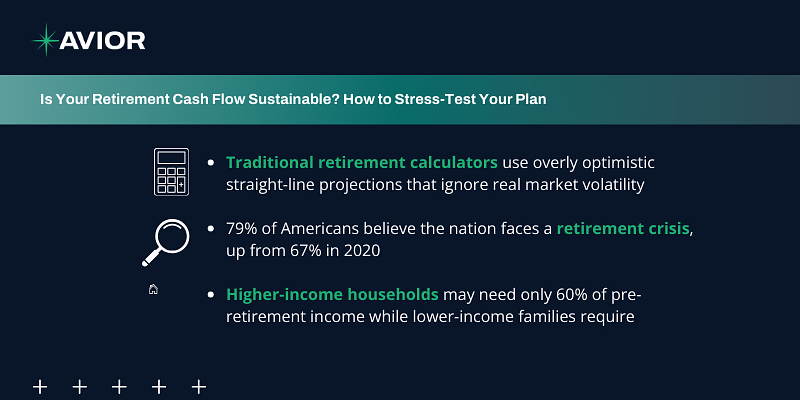Is Your Retirement Cash Flow Sustainable? How to Stress-Test Your Plan

Your retirement calculator says everything looks perfect. Steady returns, predictable expenses, and enough money to last until age 95.
But what happens when the market crashes in your first year of retirement? Or when inflation spikes and stays there? That cheerful projection might not look so rosy anymore.
Most retirement plans fail not because people didn’t save enough, but because they used overly optimistic assumptions that crumble when reality hits.
A basic retirement calculator assumes your portfolio will grow in a straight line, never accounting for the bumps, crashes, and unexpected expenses that define real life. This gap between fantasy and reality has left many retirees scrambling to adjust their lifestyles when their carefully crafted plans fall apart.
Key Takeaways
- Traditional retirement calculators use overly optimistic straight-line projections that ignore real market volatility
- 79% of Americans believe the nation faces a retirement crisis, up from 67% in 2020
- Higher-income households may need only 60% of pre-retirement income while lower-income families require up to 90%
- Monte Carlo analysis can test your plan against thousands of market scenarios to reveal weak spots
- Healthcare costs represent the biggest wild card in retirement planning
- Stress testing helps identify when you need to adjust spending before running out of money
Why Basic Retirement Calculators Fail
The Straight-Line Fantasy
Most retirement calculators work like this: plug in your savings, add an expected return (usually around 6-8%), subtract your annual spending, and voila – a neat projection showing exactly when your money runs out.
What’s the problem here? Markets don’t work this way.
The S&P 500 has averaged about 10.5% annually between 1995-2024, yet the index never actually returned 10% in any single year.
Returns were either much higher or considerably lower, creating a roller coaster that basic calculators completely ignore.
The Timing Trap
When bad returns hit matters enormously.
A hypothetical 30% market drop in year two of retirement devastates your portfolio differently than the same drop 15 years later.
Early losses force you to sell more shares to maintain your lifestyle, leaving fewer shares to recover when markets rebound.
This “sequence of returns risk” can derail even well-funded retirement plans, yet simple calculators assume returns happen in perfect order.
What Real Retirement Looks Like
Income Replacement Isn’t One-Size-Fits-All
The old rule of needing 75-80% of your working income in retirement doesn’t fit everyone. Research reveals huge variations based on your situation.
Higher-income households saving 20% or more may need only 60% of pre-retirement income, while lower-earning families could require up to 90%.
Why the difference? High earners stop saving for retirement once they retire, immediately reducing their income needs.
They also pay less in taxes and often downsize their lifestyles.
The Healthcare Wild Card
Healthcare represents the biggest unknown in retirement planning. Medicare doesn’t cover everything, and long-term care costs can destroy even substantial savings.
Many retirees find themselves helping adult children financially or dealing with unexpected home repairs that weren’t in any calculator.
These unplanned expenses explain why nudging your income replacement rate higher provides crucial wiggle room.
Stress-Testing Your Plan
Monte Carlo Analysis
Instead of assuming perfect returns forever, Monte Carlo analysis runs your retirement plan through thousands of different market scenarios.
Some simulations might start with a 30% crash followed by strong recovery. Others might show years of flat returns or extended bear markets.
The result? A probability of success rather than false certainty. If your plan succeeds in 85% of scenarios, you can retire with confidence.
If it fails in half the simulations, you need to make adjustments.
Historical Backtesting
This approach tests your withdrawal plan against actual historical market periods.
Would your strategy have worked if you retired in 1929, right before the Great Depression? How about 2008, during the financial crisis?
Historical backtesting shows how your plan performs during the worst market conditions we’ve experienced.
Present Value Analysis
This method calculates whether your current savings can fund your projected withdrawals.
Using discount rates and cash flow projections, it determines if you’re mathematically on track. Think of it like a business analyzing whether an investment pays for itself.
Building a More Resilient Plan
Create Spending Flexibility
Build multiple spending levels into your retirement plan. Essential expenses – housing, food, healthcare – represent your floor.
Discretionary spending on travel and entertainment becomes your ceiling. During market downturns, you can cut discretionary expenses without affecting your basic lifestyle.
This flexibility dramatically improves your plan’s success rate because you’re not locked into rigid spending targets.
Sequence Your Withdrawals
Rather than selling investments randomly, develop a systematic approach.
During periods of market volatility, consider if changes to your investment approach are warranted.
Possible changes to consider may be tapping cash reserves or bonds first, letting your stock investments recover when the market is low; or rebalancing by taking gains from stocks and rebuilding your cash cushion when the market is high.
Plan for the Unexpected
Stress testing reveals how various shocks affect your retirement security. What if you need long-term care?
What if inflation stays high for years? What if you want to help your children buy homes?
By modeling these scenarios, you can build buffers into your plan before problems arise.
Red Flags in Your Retirement Plan
Unrealistic Return Assumptions
If your plan assumes consistent 8-10% returns throughout retirement, it’s probably too optimistic.
Most retirees shift to more conservative portfolios as they age, reducing expected returns. Factor in sequence of returns risk and real returns often fall short of projections.
Ignoring Inflation
Fixed spending assumptions ignore inflation’s erosive power. Even 3% inflation doubles prices over 24 years.
Your retirement could easily last 30+ years, making inflation a major factor in long-term planning.
No Contingency Plans
Plans that work only under perfect conditions aren’t really plans at all. If your strategy has no room for market crashes, unexpected expenses, or changes in health, it needs more robustness.
When to Adjust Your Strategy
Annual Check-ups
Review your retirement plan annually, not just when markets crash. Small adjustments early prevent major problems later.
If your portfolio falls below certain thresholds, implement spending cuts before the situation becomes dire.
Market-Based Adjustments
Some retirees use “guardrails” – predetermined rules for adjusting spending based on portfolio performance.
If your account balance drops below a certain level, spending decreases. If it grows significantly, spending can increase.
This dynamic approach keeps your plan on track without constant worry about market movements.
Work With Us
Retirement planning isn’t about finding the perfect projection – it’s about building a strategy robust enough to handle whatever reality throws your way.
While basic calculators paint rosy pictures using straight-line assumptions, real retirement success comes from stress-testing your plan against multiple scenarios and building in flexibility for the unexpected. With 79% of Americans recognizing a retirement crisis and many plans failing due to overly optimistic assumptions, the need for realistic, tested strategies has never been greater.
At Avior, we go beyond simple retirement calculators to stress-test your plan using Monte Carlo analysis, historical backtesting, and real-world scenario planning. Our approach reveals potential weaknesses before they become problems and helps build the flexibility you need to maintain your lifestyle through market volatility and life’s unexpected turns. Ready to find out if your retirement plan can handle whatever comes next? Contact Avior today to stress-test your strategy and build a retirement plan that works in the real world.
No Comments
Sorry, the comment form is closed at this time.




